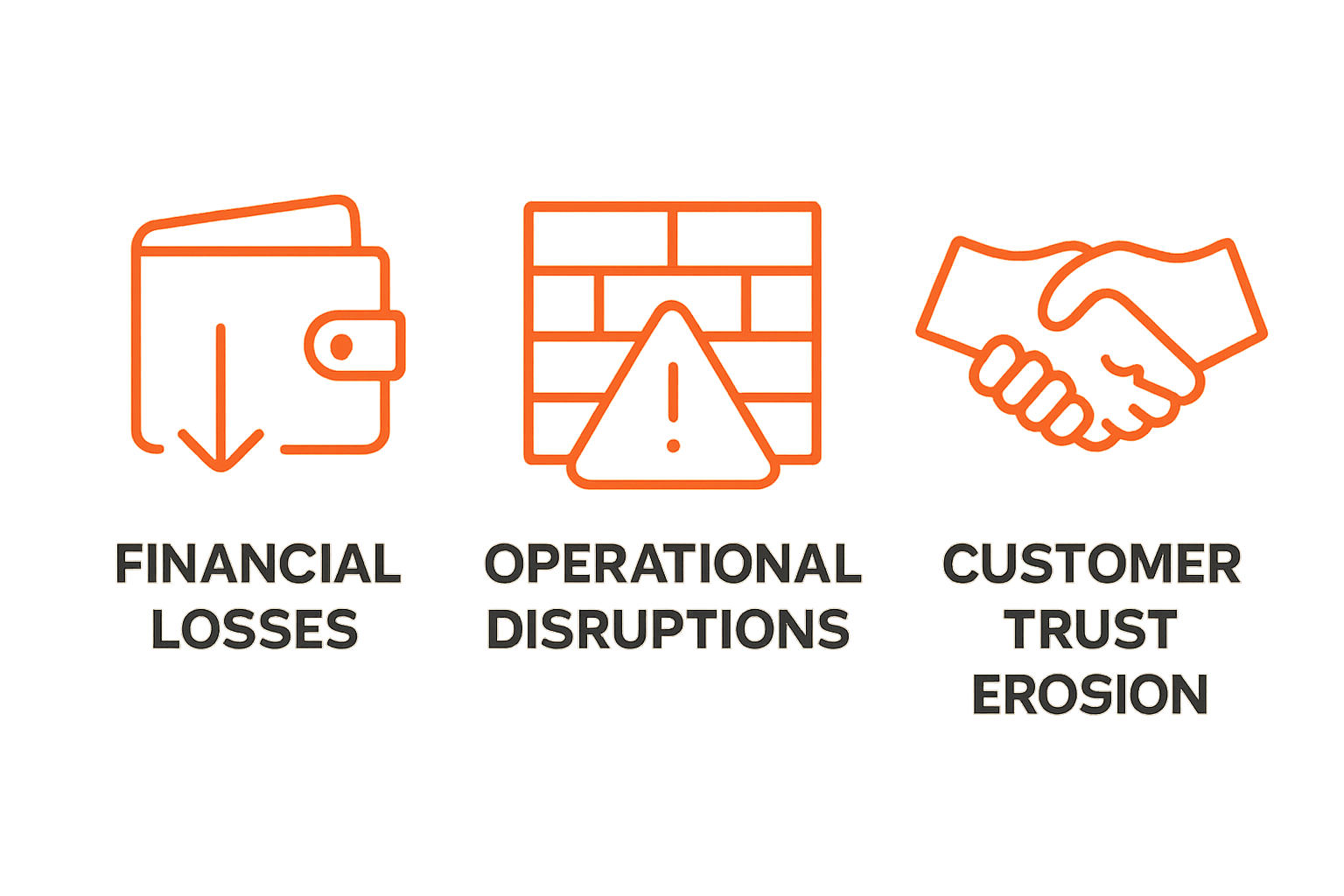Understanding Remote Desktop Security Risks for Businesses
Remote desktop security risks are no longer a distant tech problem. South African businesses face 577 cyber attacks every single hour, targeting the systems that allow remote work. But the real shock is this. The biggest threat often comes not from sophisticated software loopholes but from the laptops and phones your own staff use every day.
Table of Contents
- What Are Remote Desktop Security Risks?
- Why Remote Desktop Security Risks Matter For Businesses
- How Remote Desktop Protocol Works And Its Vulnerabilities
- Key Concepts In Remote Desktop Security Management
- Real-World Examples Of Remote Desktop Security Breaches
Quick Summary
| Takeaway | Explanation |
|---|---|
| Implement strong authentication measures | Multi-factor authentication significantly reduces unauthorized access risks to remote desktop systems. |
| Protect endpoint devices rigorously | Personal devices lack security controls, increasing vulnerability to cyber threats. Secure these devices to prevent data breaches. |
| Regularly audit network access permissions | Continuous monitoring of network permissions helps identify and mitigate potential security breaches proactively. |
| Segment networks to enhance security | Create distinct zones within your network to limit exposure and minimize risks from unauthorized access. |
| Invest in employee cybersecurity training | Educating employees about remote desktop security can dramatically lower the likelihood of successful cyberattacks. |
What are Remote Desktop Security Risks?
Remote desktop security risks represent significant vulnerabilities that can expose businesses to unauthorized network access, data breaches, and potential cyberattacks. These risks emerge when organizations enable remote connections between computer systems without implementing robust security protocols.
Unauthorized Network Intrusion
Remote desktop protocols create potential entry points for malicious actors seeking to penetrate corporate networks. According to CISA, threat actors frequently use malicious Remote Desktop Protocol (RDP) files to gain unauthorized access to organizational networks. These intrusions can enable attackers to:
- Deploy harmful malware
- Steal sensitive corporate information
- Establish persistent network access
- Compromise multiple connected systems
Endpoint Device Vulnerabilities
Personal devices used for remote work introduce substantial security challenges. Research from the University of the Witwatersrand highlights that employee-owned devices frequently lack critical security controls, making them prime targets for cybercriminals.
Compromised endpoint devices can create significant risks, including potential:
- Data interception
- Credential theft
- Unauthorized network access
- Malware transmission across corporate infrastructure
Businesses must recognize that remote desktop security is not merely a technical challenge but a comprehensive risk management strategy requiring continuous monitoring, robust authentication mechanisms, and proactive security protocols.
The table below compares the two core categories of remote desktop security risks faced by businesses, summarising the main vulnerabilities and typical consequences for each.
| Security Risk Category | Main Vulnerabilities | Typical Consequences |
|---|---|---|
| Unauthorized Network Intrusion | Malicious RDP files, weak authentication, inadequate monitoring | Malware deployment, data theft, persistence |
| Endpoint Device Vulnerabilities | Lack of security controls on personal devices, unsecured access | Data interception, credential theft, malware |
Why Remote Desktop Security Risks Matter for Businesses
Remote desktop security risks present more than technical challenges they represent significant financial and operational threats that can potentially devastate business sustainability and reputation. Organizations must understand the profound implications of these vulnerabilities.
Financial Impact of Security Breaches
Research from Accenture reveals that South African businesses experience 577 cyber-attacks per hour, underscoring the critical nature of robust security protocols. These attacks can result in substantial financial losses through:

- Direct monetary theft
- Operational disruptions
- Regulatory compliance penalties
- Reputation damage
- Customer trust erosion
Operational Vulnerability Landscape
Cybercriminals exploit remote desktop vulnerabilities as strategic entry points into organizational networks. With increasing remote work adoption, businesses become more susceptible to sophisticated attack methodologies. When network access is compromised, attackers can:
-
Infiltrate sensitive database systems
-
Extract confidential corporate information
-
Manipulate critical infrastructure
-
Install persistent malware
Businesses must recognize that remote desktop security is not optional but a fundamental requirement for maintaining operational integrity. Learn more about our server migration strategies to enhance your network’s resilience against emerging cybersecurity threats.
How Remote Desktop Protocol Works and Its Vulnerabilities
Remote Desktop Protocol (RDP) enables users to connect and control computer systems from distant locations, functioning as a critical technology for remote work and distributed business operations. While providing significant flexibility, RDP introduces complex security challenges that organizations must carefully navigate.
Technical Architecture of RDP
At its core, RDP establishes a secure communication channel between a client computer and a remote server, transmitting graphical interface information and user input commands. The protocol operates by encapsulating session data through encrypted network connections, allowing seamless interaction across different geographical locations.
Key architectural components include:
- Network port mapping
- Encrypted communication channels
- Authentication mechanisms
- Session management protocols
- Graphical interface transmission
Inherent Security Vulnerabilities
According to CISA, RDP contains critical vulnerabilities that can potentially expose entire network infrastructures to malicious intrusions. These vulnerabilities emerge from several technical weaknesses:
- Potential remote code execution risks
- Insufficient authentication controls
- Complex encryption challenges
- Susceptibility to brute force attacks
- Inadequate default security configurations
Businesses must implement robust security strategies to mitigate these risks, including strong password policies, network segmentation, and continuous monitoring of remote access points. By understanding RDP’s technical nuances, organizations can develop comprehensive protection mechanisms that balance operational efficiency with cybersecurity resilience.
The following table outlines key features of Remote Desktop Protocol (RDP), pairing each technical component with its associated vulnerability for easier reference.
| RDP Feature | Associated Vulnerability |
|---|---|
| Network port mapping | Exposed entry point for attackers |
| Encrypted communication channels | Complex encryption challenges |
| Authentication mechanisms | Insufficient controls, brute force risks |
| Session management protocols | Potential remote code execution |
| Graphical interface transmission | Data leakage or interception risks |
Key Concepts in Remote Desktop Security Management
Remote desktop security management represents a comprehensive approach to protecting organizational networks from potential cyber threats. It requires strategic implementation of multiple protective layers and proactive monitoring mechanisms to ensure comprehensive digital infrastructure safety.
Authentication and Access Control
Strong authentication protocols form the foundational defense mechanism against unauthorized network access. Implementing multi-factor authentication creates additional verification layers that significantly reduce potential security breaches. According to University of Cape Town’s CSIRT, organizations should prioritize:
- Complex password creation techniques
- Regular password rotation schedules
- Implementing multi-factor authentication
- Restricting administrative access privileges
- Monitoring login attempts and suspicious activities
Network Segmentation and Monitoring
Effective remote desktop security management demands robust network segmentation strategies that isolate critical infrastructure components. By creating distinct network zones with controlled access points, businesses can minimize potential attack surfaces and contain potential security incidents.
Key network segmentation principles include:
- Implementing virtual private networks (VPNs)
- Creating network access control lists
- Establishing firewall configurations
- Developing comprehensive incident response protocols
- Regularly auditing network access permissions
Businesses must recognize that remote desktop security is an ongoing process requiring continuous adaptation, technological investment, and employee training to maintain effective protection against evolving cyber threats.
Real-World Examples of Remote Desktop Security Breaches
Cybersecurity incidents involving remote desktop vulnerabilities demonstrate the profound potential for organizational disruption and financial damage. These real-world scenarios underscore the critical importance of implementing comprehensive security strategies and proactive threat mitigation.
Government Sector Cybersecurity Compromises
The South African Department of Justice and Constitutional Development experienced a catastrophic ransomware attack that effectively paralyzed its entire information system infrastructure. This breach revealed multiple critical vulnerabilities:
- Complete encryption of departmental information systems
- Disruption of electronic service delivery
- Suspension of critical public services
- Compromised communication channels
- Significant operational and reputational damage
Infrastructure and Technology System Vulnerabilities
Cyber intrusions extend beyond immediate operational disruptions, potentially compromising sensitive organizational data and exposing critical infrastructure to long-term risks.
 The systematic nature of these breaches highlights the sophisticated methodologies employed by modern cybercriminals.
The systematic nature of these breaches highlights the sophisticated methodologies employed by modern cybercriminals.
Significant breach characteristics typically include:
- Unauthorized network access
- Data exfiltration capabilities
- Persistent system infiltration
- Exploitation of remote desktop protocol weaknesses
- Potential for widespread infrastructure compromise
These examples demonstrate that remote desktop security is not merely a technical challenge but a complex risk management issue requiring continuous vigilance, advanced technological solutions, and strategic organizational preparedness.
Secure Your Remote Workforce with Proven IT Expertise
Worried about remote desktop threats putting your business at risk? The recent article highlights how hackers target remote connections, exploit weak authentication, and use vulnerable endpoints to compromise data and disrupt operations. If you manage a professional firm or oversee a growing team, these security gaps can quickly become business-critical challenges. Protecting your network, confidential files, and service uptime demands smart solutions and proactive oversight.
At Techtron, we help South African businesses close these gaps with tailored IT management and expert network security. Our team delivers robust multi-factor authentication, remote monitoring, and continuous threat detection to keep your remote desktop access secure. Stay one step ahead of attacks and compliance headaches with managed services purpose-built for high-trust, high-performance businesses. Learn more about how our cybersecurity strategies and resilient cloud solutions protect your team wherever they work. Ready to take control of your remote desktop security? Visit our site now and connect with specialists who will help you secure your organisation before the next threat strikes.
Frequently Asked Questions
What are the primary remote desktop security risks for businesses?
Remote desktop security risks for businesses include unauthorized network intrusion, endpoint device vulnerabilities, and potential exposure to cyber-attacks, which can lead to data breaches and financial losses.
How does Remote Desktop Protocol (RDP) work and what are its vulnerabilities?
RDP allows users to connect and control computers remotely. Its vulnerabilities include insufficient authentication controls, potential remote code execution risks, and susceptibility to brute force attacks, making it crucial for businesses to implement security measures.
What measures can businesses take to enhance remote desktop security?
Businesses can improve remote desktop security by implementing strong authentication protocols, such as multi-factor authentication, performing regular password rotations, ensuring network segmentation, and continuously monitoring access points for suspicious activities.
Why is it important for businesses to address remote desktop security risks?
Addressing remote desktop security risks is vital to protect sensitive corporate information, maintain operational integrity, and avoid financial repercussions resulting from cyber-attacks, which may include monetary theft and reputational damage.